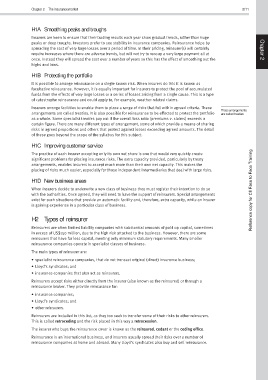Page 49 - W01TB8_2017-18_[low-res]_F2F_Neat
P. 49
Chapter 2 The insurance market 2/11
H1A Smoothing peaks and troughs
Insurers are keen to ensure that their trading results each year show gradual trends, rather than huge
peaks or deep troughs. Investors prefer to see stability in insurance companies. Reinsurance helps by
spreading the cost of very large losses over a period of time. In their pricing, reinsurer(s) will certainly Chapter
require increases where there are adverse trends, but will not try to recoup a very large payment all at
once. Instead they will spread the cost over a number of years so this has the effect of smoothing out the 2
highs and lows.
H1B Protecting the portfolio
It is possible to arrange reinsurance on a single known risk. When insurers do this it is known as
facultative reinsurance. However, it is equally important for insurers to protect the pool of accumulated
funds from the effects of very large losses or a series of losses arising from a single cause. This is a type
of catastrophe reinsurance and could apply to, for example, weather-related claims.
Insurers arrange facilities to enable them to place a range of risks that fall within agreed criteria. These
These arrangements
arrangements are called treaties. It is also possible for reinsurance to be effected to protect the portfolio are called treaties
as a whole. Some specialist treaties pay out if the overall loss ratio (premiums v. claims) exceeds a
certain figure. There are many different types of arrangement, some of which provide a means of sharing
risks in agreed proportions and others that protect against losses exceeding agreed amounts. The detail
of these goes beyond the scope of the syllabus for this subject.
H1C Improving customer service
The practice of each insurer accepting only its own net share is one that would very quickly create
significant problems for placing insurance risks. The extra capacity provided, particularly by treaty
arrangements, enables insurers to accept much more than their own net capacity. This makes the
placing of risks much easier, especially for those independent intermediaries that deal with large risks.
H1D New business areas
When insurers decide to underwrite a new class of business they must register their intention to do so Reference copy for CII Face to Face Training
with the authorities. Once agreed, they will need to have the support of reinsurers. Special arrangements
exist for such situations that provide an automatic facility and, therefore, extra capacity, while an insurer
is gaining experience in a particular class of business.
H2 Types of reinsurer
Reinsurers are often limited liability companies with substantial amounts of paid up capital, sometimes
in excess of US$150 million, due to the high risk attached to the business. However, there are some
reinsurers that have far less capital, meeting only minimum statutory requirements. Many smaller
reinsurance companies operate in specialist classes of business.
The main types of reinsurer are:
• specialist reinsurance companies, that do not transact original (direct) insurance business;
• Lloyd’s syndicates; and
• insurance companies that also act as reinsurers.
Reinsurers accept risks either directly from the insurer (also known as the reinsured) or through a
reinsurance broker. They provide reinsurance for:
• insurance companies;
• Lloyd’s syndicates; and
• other reinsurers.
Reinsurers are included in this list, as they too seek to transfer some of their risks to other reinsurers.
This is called retroceding and the risk placed in this way a retrocession.
The insurer who buys the reinsurance cover is known as the reinsured, cedant or the ceding office.
Reinsurance is an international business, and insurers usually spread their risks over a number of
reinsurance companies at home and abroad. Many Lloyd’s syndicates also buy and sell reinsurance.

